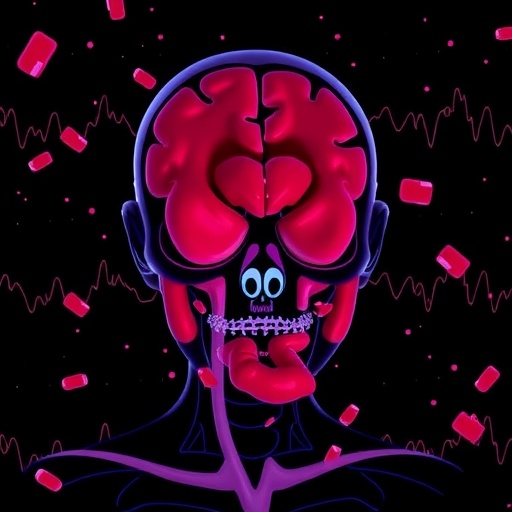Tardive dyskinesia (TD), a chronic and often debilitating movement disorder, continues to challenge the field of psychiatry, particularly in its recognition and diagnosis. Associated predominantly with long-term use of antipsychotic medications, TD manifests through involuntary, repetitive movements primarily affecting the face, tongue, and extremities. Despite advancements in psychiatric care, the disorder remains underdiagnosed and frequently misreported in routine clinical practice, posing significant barriers to effective patient management and timely intervention.
A groundbreaking study published in BMC Psychiatry in 2025 sheds new light on the diagnostic discrepancy surrounding TD. By leveraging semi-structured electronic health record (EHR) data from a vast range of healthcare settings in the United States, researchers aimed to quantify the gap between patients exhibiting symptoms consistent with TD and those who receive an official diagnosis coded in medical records. This large-scale retrospective analysis offers unprecedented insight into the prevalence of undiagnosed or misdiagnosed TD, exposing critical pitfalls in current clinical workflows.
The study encompassed over 32,000 adults diagnosed with schizophrenia-spectrum disorders, major depressive disorder with psychotic features, or bipolar disorder with psychosis—all patient groups typically managed with antipsychotic therapy and at risk for TD development. Researchers meticulously examined both structured and unstructured components of electronic health records gathered from 1999 through 2021. Semi-structured data, detailing recorded abnormal movements noted during mental state examinations, were extracted manually to identify patients showing signs of TD but absent a formal diagnosis.
This approach revealed that 4% of the selected cohort exhibited documented abnormal movements potentially indicative of TD. However, among these patients, a strikingly low proportion—less than 5%—had an ICD-coded diagnosis of TD within the structured data portions of their records. Even when focusing exclusively on those patients with explicitly documented TD symptoms, only 9.2% had received an appropriate diagnostic code, underscoring a substantial gap between clinical observation and formal recognition within healthcare documentation systems.
Importantly, the study identified demographic and institutional factors influencing the likelihood of receiving a formal TD diagnosis. Patients identifying as Black/African-American showed significantly lower odds of an ICD-coded diagnosis compared to White patients, suggesting potential disparities in diagnosis or access to specialized care. Conversely, treatment in community mental health centers was associated with an increased probability of documentation compared to academic medical centers, highlighting how institutional settings might affect clinical coding practices and ultimately patient care pathways.
The findings call for urgent improvements in clinician awareness and training aimed at robustly identifying TD symptoms. Given the complexity and subtlety of TD presentation, reliable diagnosis often requires a nuanced understanding of movement disorders alongside careful clinical documentation. Improving the precision and consistency of TD diagnosis could facilitate timely interventions and broaden access to emerging therapeutic options developed specifically to address this condition.
Diagnostic ambiguity surrounding TD hampers the ability to accurately assess its true prevalence and burden on patient populations undergoing antipsychotic treatment. Many patients likely endure prolonged periods of untreated symptoms, leading to diminished quality of life, social stigma, and functional impairment. This study’s innovative use of semi-structured EHR data reveals that much of this suffering may be invisible within traditional coding systems, illuminating hidden clinical realities masked by administrative limitations.
The use of electronic health records offers powerful tools to bridge the diagnostic divide, yet it also exposes systemic deficiencies in capturing complex neuropsychiatric phenomena. By combining manual review techniques with structured data extraction, the research establishes a methodological precedent for future epidemiological and clinical investigations into neuropsychiatric side effects and movement disorders beyond TD. This multidimensional data approach enhances the granularity and accuracy of patient characterization.
In practical terms, the study’s results suggest that healthcare providers should integrate more detailed movement assessments into routine psychiatric evaluations, particularly for high-risk populations receiving chronic antipsychotic therapy. An emphasis on meticulous symptom documentation, combined with appropriate ICD coding practices, could streamline clinical decision-making and facilitate engagement with specialty neurology and psychiatry services that focus on movement disorder management.
Moreover, the detected racial disparities emphasize the need for equity-driven interventions to ensure that all patient demographics receive appropriate diagnostic consideration and subsequent treatment opportunities. Healthcare systems must address potential biases and structural barriers that hinder the recognition of neuropsychiatric complications in minority populations, thereby fostering more inclusive and effective mental health care.
While novel pharmacological treatments for TD have emerged, their success hinges on timely diagnosis and referral. The diagnostic gap unveiled by this study highlights a fundamental clinical challenge: medication advancements alone cannot close quality-of-care gaps without simultaneous improvements in detection and documentation. Future research will need to explore integrative strategies combining clinical training, health informatics, and patient advocacy to comprehensively address TD underdiagnosis.
Overall, this research contributes to a growing awareness that movement disorders like TD require a multifaceted approach encompassing clinical vigilance, systematic record-keeping, and health equity considerations. By unraveling diagnostic patterns hidden within semi-structured health data, it provides a clarion call to psychiatry professionals to refine diagnostic protocols and embrace comprehensive patient-centered care models that acknowledge and address the complexities of TD.
In conclusion, the study not only quantifies the diagnostic gap of tardive dyskinesia but also contextualizes it within demographic and institutional frameworks, making a compelling case for urgent enhancements in clinical practice. Bridging this gap is essential to improving patient outcomes, expanding access to innovative therapies, and ultimately mitigating the pervasive burden of this challenging disorder.
Subject of Research: Diagnostic disparities and underrecognition of tardive dyskinesia in psychiatric populations using electronic health records.
Article Title: Identifying the diagnostic gap of tardive dyskinesia: an analysis of semi-structured electronic health record data.
Article References:
Griffiths, K., Won, Y., Lee, Z. et al. Identifying the diagnostic gap of tardive dyskinesia: an analysis of semi-structured electronic health record data. BMC Psychiatry 25, 407 (2025). https://doi.org/10.1186/s12888-025-06780-w
Image Credits: AI Generated




